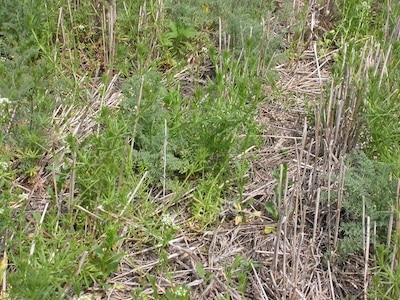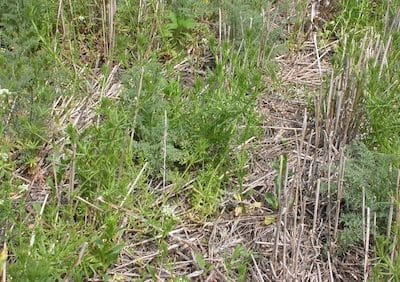
Early weed control means higher yields. But so does early seeding. Before deciding which to do first, assess your weed situation. Fields with a high population of winter annuals and perennials will benefit from a pre-seed burnoff.
Research shows that a pre-seed burnoff will result in higher yields versus no pre-seed burnoff. After the snow has cleared, start walking fields to see what weeds are present and how fast they’re advancing. Seeding can begin fairly soon after a burnoff. For annuals and winter annuals, glyphosate needs only 24 hours to get to the growing point. After a day, the crop can be seeded. For perennial weeds, 3 days should be enough in sunny and warm conditions but 5 days is recommended before seeding if weather is cloudy or cool.
Pre-seed burnoff and night temperatures. Applications of glyphosate and many other herbicides made in cold conditions often result in poor weed control. For example, cloudy days with highs of 10°C after a night near 0°C will often result in poor herbicide performance. Biological activity would have stopped when temperatures drop below 5°C and would not start up again until the plant warmed to at least 5°C — and even then it would be very slow. No biological activity means no herbicide activity. Ideally glyphosate applications will be made:
—When temperatures are greater than 10°C, with the expectation that daytime highs will increase to greater than 15°C
—When nighttime lows are greater than 5°C (the warmer the better up to 10°C)
—Under bright sunshine (thin or sporadic clouds are also OK). Applications made in darkness or heavy cloud are less effective.
—Using water with low levels of hard water ions (Ca and Mg), iron, or suspended clay or organic matter.
Post-seeding pre-emergence window. If choosing to seed before spraying, weeds present will have a whole week or more before the crop emerges, and can advance very quickly in good conditions. Growers who make this decision may want to apply in the narrow post-seeding pre-emergence window. If that window is missed, early in-crop weed management is essential to hold yield potential. Some yield potential is likely already lost to weeds by that time.

